Cognitive Revolution: Appropriateness of Brain-Computer Comparison
VerifiedAdded on 2023/06/15
|11
|2576
|253
Essay
AI Summary
This essay delves into the cognitive revolution, examining the appropriateness of comparing the human brain to a computer. It begins by introducing the cognitive revolution as a response to behaviorism, highlighting the development of information processing theory. The theory posits that the human mind transforms sensory information, similar to how computers process data. The essay explores the strengths of this comparison, noting how it aids in understanding mental processes like attention, encoding, and retrieval. However, it also addresses the limitations, emphasizing the differences in control, processing, and the influence of emotional and motivational factors. The essay further discusses the challenges in applying the information processing model, such as the assumption of serial processing and the artificiality of controlled experiments. It concludes that while the computer analogy provides valuable insights, it cannot fully explain the complexities of human behavior due to the brain's capacity for parallel processing, the impact of past experiences, and the integration of emotional and motivational elements.
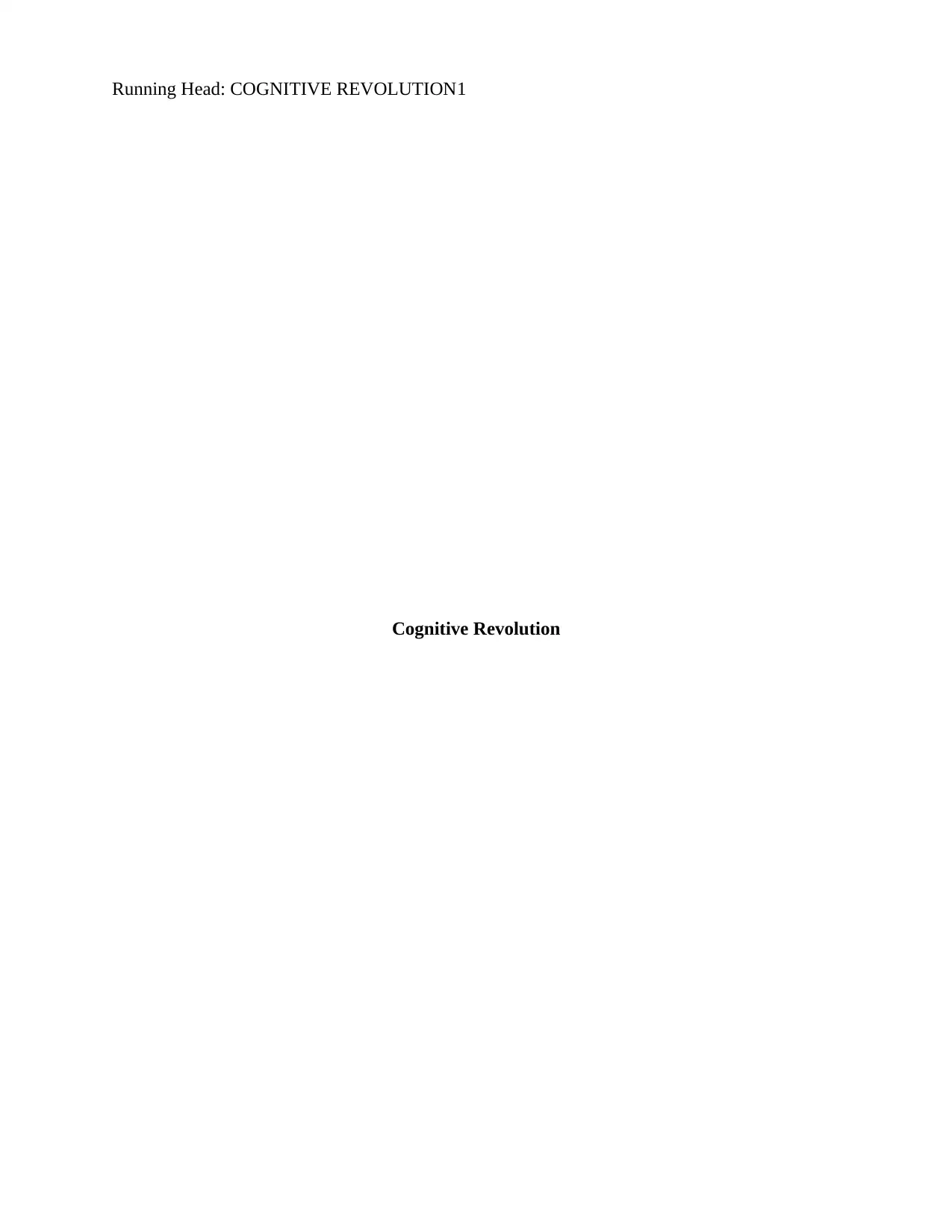
Running Head: COGNITIVE REVOLUTION1
Cognitive Revolution
Cognitive Revolution
Paraphrase This Document
Need a fresh take? Get an instant paraphrase of this document with our AI Paraphraser
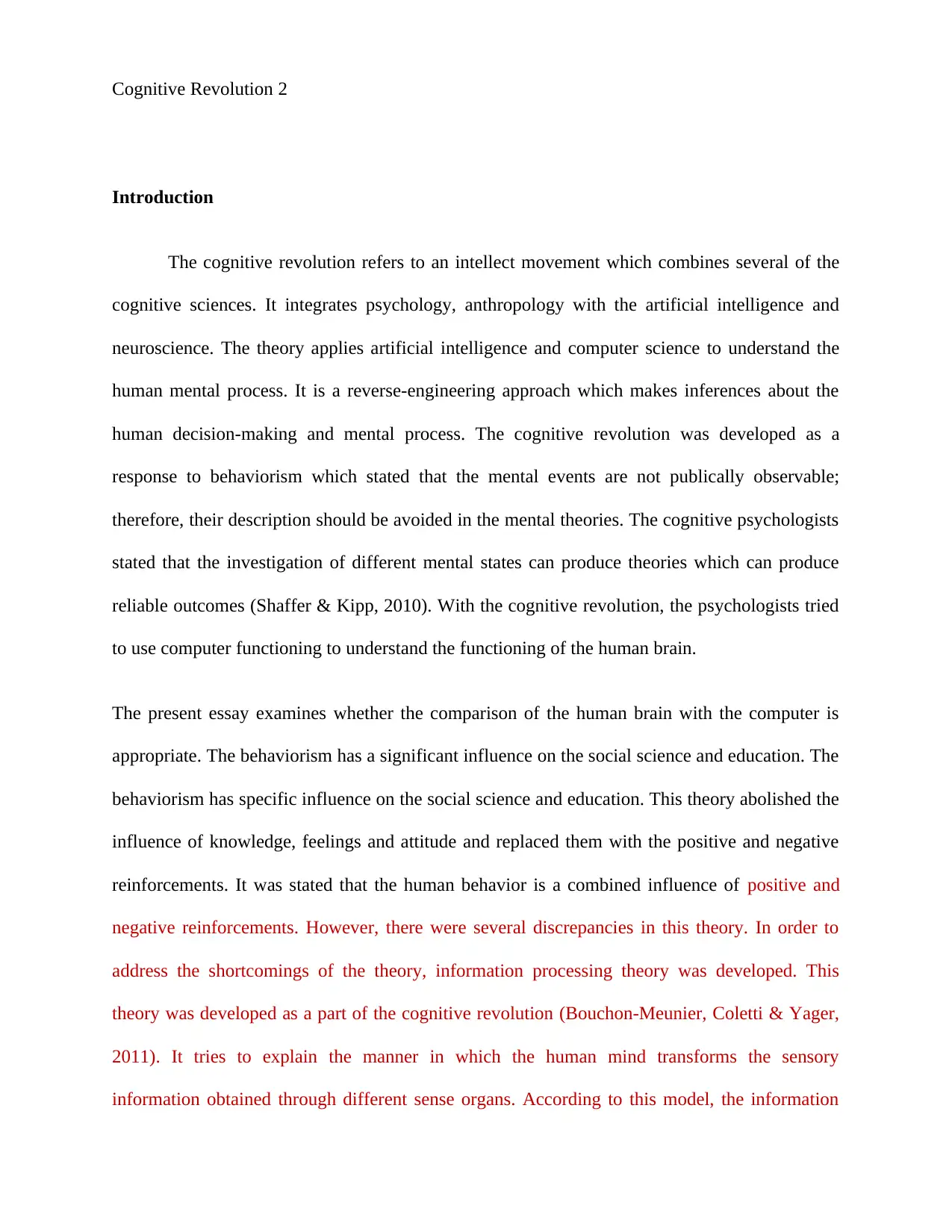
Cognitive Revolution 2
Introduction
The cognitive revolution refers to an intellect movement which combines several of the
cognitive sciences. It integrates psychology, anthropology with the artificial intelligence and
neuroscience. The theory applies artificial intelligence and computer science to understand the
human mental process. It is a reverse-engineering approach which makes inferences about the
human decision-making and mental process. The cognitive revolution was developed as a
response to behaviorism which stated that the mental events are not publically observable;
therefore, their description should be avoided in the mental theories. The cognitive psychologists
stated that the investigation of different mental states can produce theories which can produce
reliable outcomes (Shaffer & Kipp, 2010). With the cognitive revolution, the psychologists tried
to use computer functioning to understand the functioning of the human brain.
The present essay examines whether the comparison of the human brain with the computer is
appropriate. The behaviorism has a significant influence on the social science and education. The
behaviorism has specific influence on the social science and education. This theory abolished the
influence of knowledge, feelings and attitude and replaced them with the positive and negative
reinforcements. It was stated that the human behavior is a combined influence of positive and
negative reinforcements. However, there were several discrepancies in this theory. In order to
address the shortcomings of the theory, information processing theory was developed. This
theory was developed as a part of the cognitive revolution (Bouchon-Meunier, Coletti & Yager,
2011). It tries to explain the manner in which the human mind transforms the sensory
information obtained through different sense organs. According to this model, the information
Introduction
The cognitive revolution refers to an intellect movement which combines several of the
cognitive sciences. It integrates psychology, anthropology with the artificial intelligence and
neuroscience. The theory applies artificial intelligence and computer science to understand the
human mental process. It is a reverse-engineering approach which makes inferences about the
human decision-making and mental process. The cognitive revolution was developed as a
response to behaviorism which stated that the mental events are not publically observable;
therefore, their description should be avoided in the mental theories. The cognitive psychologists
stated that the investigation of different mental states can produce theories which can produce
reliable outcomes (Shaffer & Kipp, 2010). With the cognitive revolution, the psychologists tried
to use computer functioning to understand the functioning of the human brain.
The present essay examines whether the comparison of the human brain with the computer is
appropriate. The behaviorism has a significant influence on the social science and education. The
behaviorism has specific influence on the social science and education. This theory abolished the
influence of knowledge, feelings and attitude and replaced them with the positive and negative
reinforcements. It was stated that the human behavior is a combined influence of positive and
negative reinforcements. However, there were several discrepancies in this theory. In order to
address the shortcomings of the theory, information processing theory was developed. This
theory was developed as a part of the cognitive revolution (Bouchon-Meunier, Coletti & Yager,
2011). It tries to explain the manner in which the human mind transforms the sensory
information obtained through different sense organs. According to this model, the information
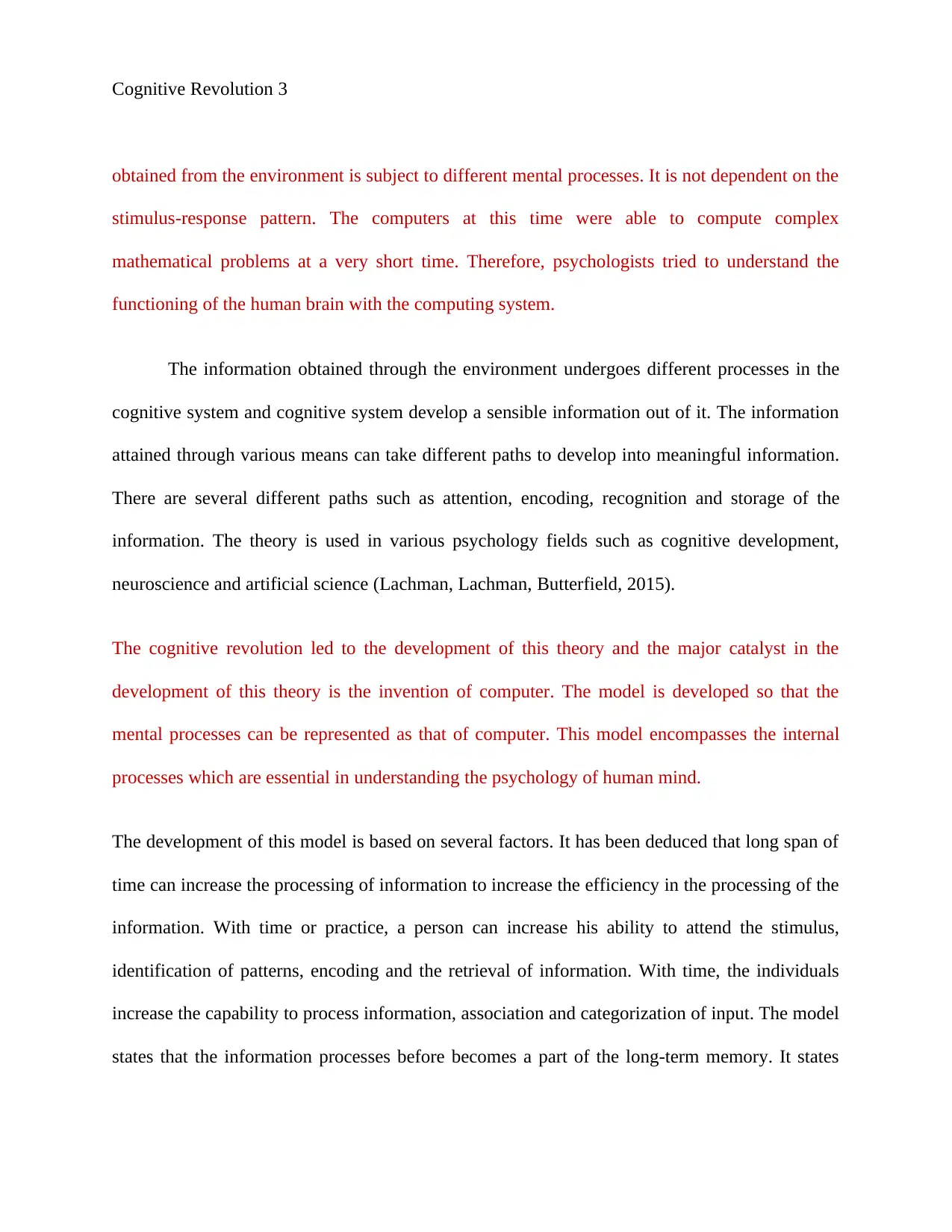
Cognitive Revolution 3
obtained from the environment is subject to different mental processes. It is not dependent on the
stimulus-response pattern. The computers at this time were able to compute complex
mathematical problems at a very short time. Therefore, psychologists tried to understand the
functioning of the human brain with the computing system.
The information obtained through the environment undergoes different processes in the
cognitive system and cognitive system develop a sensible information out of it. The information
attained through various means can take different paths to develop into meaningful information.
There are several different paths such as attention, encoding, recognition and storage of the
information. The theory is used in various psychology fields such as cognitive development,
neuroscience and artificial science (Lachman, Lachman, Butterfield, 2015).
The cognitive revolution led to the development of this theory and the major catalyst in the
development of this theory is the invention of computer. The model is developed so that the
mental processes can be represented as that of computer. This model encompasses the internal
processes which are essential in understanding the psychology of human mind.
The development of this model is based on several factors. It has been deduced that long span of
time can increase the processing of information to increase the efficiency in the processing of the
information. With time or practice, a person can increase his ability to attend the stimulus,
identification of patterns, encoding and the retrieval of information. With time, the individuals
increase the capability to process information, association and categorization of input. The model
states that the information processes before becomes a part of the long-term memory. It states
obtained from the environment is subject to different mental processes. It is not dependent on the
stimulus-response pattern. The computers at this time were able to compute complex
mathematical problems at a very short time. Therefore, psychologists tried to understand the
functioning of the human brain with the computing system.
The information obtained through the environment undergoes different processes in the
cognitive system and cognitive system develop a sensible information out of it. The information
attained through various means can take different paths to develop into meaningful information.
There are several different paths such as attention, encoding, recognition and storage of the
information. The theory is used in various psychology fields such as cognitive development,
neuroscience and artificial science (Lachman, Lachman, Butterfield, 2015).
The cognitive revolution led to the development of this theory and the major catalyst in the
development of this theory is the invention of computer. The model is developed so that the
mental processes can be represented as that of computer. This model encompasses the internal
processes which are essential in understanding the psychology of human mind.
The development of this model is based on several factors. It has been deduced that long span of
time can increase the processing of information to increase the efficiency in the processing of the
information. With time or practice, a person can increase his ability to attend the stimulus,
identification of patterns, encoding and the retrieval of information. With time, the individuals
increase the capability to process information, association and categorization of input. The model
states that the information processes before becomes a part of the long-term memory. It states
⊘ This is a preview!⊘
Do you want full access?
Subscribe today to unlock all pages.

Trusted by 1+ million students worldwide
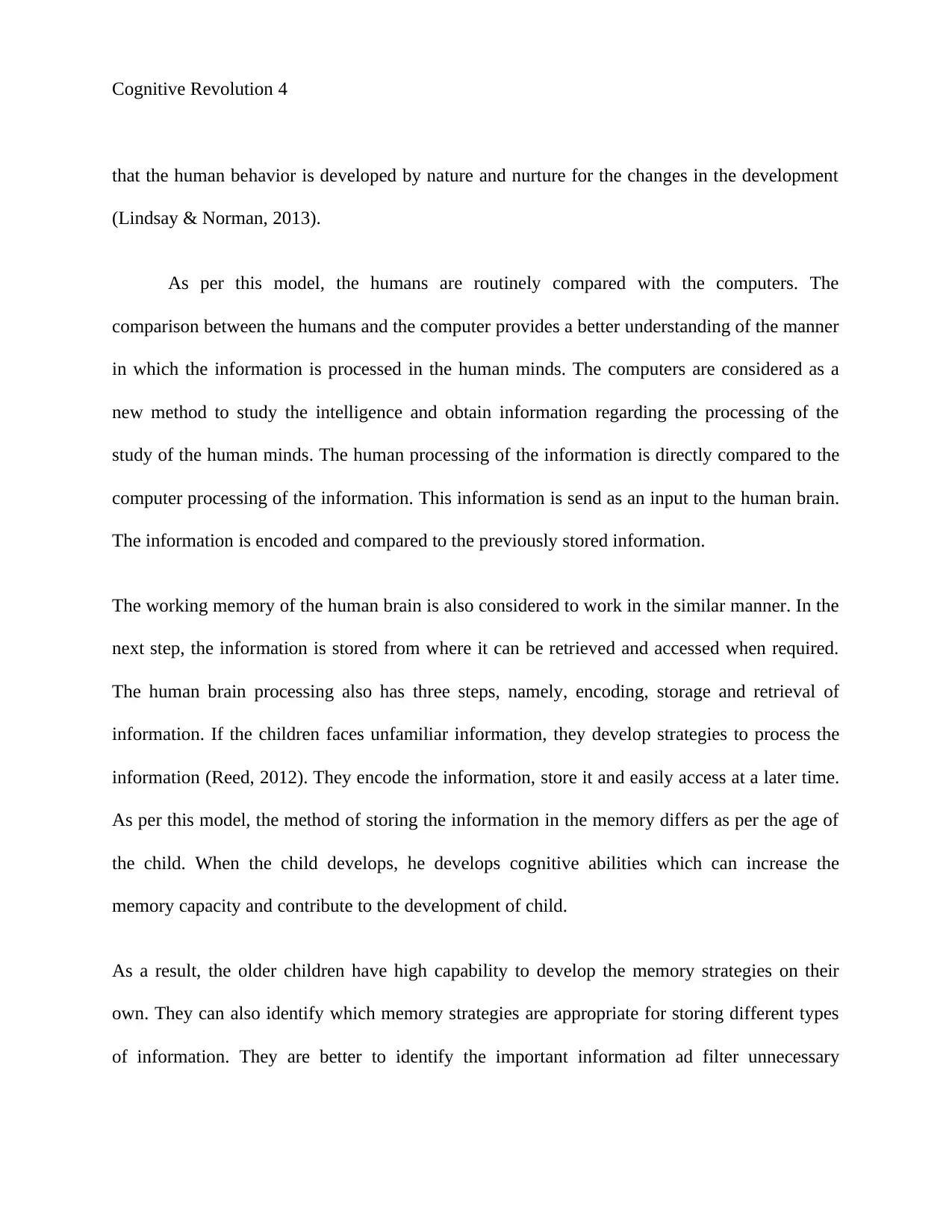
Cognitive Revolution 4
that the human behavior is developed by nature and nurture for the changes in the development
(Lindsay & Norman, 2013).
As per this model, the humans are routinely compared with the computers. The
comparison between the humans and the computer provides a better understanding of the manner
in which the information is processed in the human minds. The computers are considered as a
new method to study the intelligence and obtain information regarding the processing of the
study of the human minds. The human processing of the information is directly compared to the
computer processing of the information. This information is send as an input to the human brain.
The information is encoded and compared to the previously stored information.
The working memory of the human brain is also considered to work in the similar manner. In the
next step, the information is stored from where it can be retrieved and accessed when required.
The human brain processing also has three steps, namely, encoding, storage and retrieval of
information. If the children faces unfamiliar information, they develop strategies to process the
information (Reed, 2012). They encode the information, store it and easily access at a later time.
As per this model, the method of storing the information in the memory differs as per the age of
the child. When the child develops, he develops cognitive abilities which can increase the
memory capacity and contribute to the development of child.
As a result, the older children have high capability to develop the memory strategies on their
own. They can also identify which memory strategies are appropriate for storing different types
of information. They are better to identify the important information ad filter unnecessary
that the human behavior is developed by nature and nurture for the changes in the development
(Lindsay & Norman, 2013).
As per this model, the humans are routinely compared with the computers. The
comparison between the humans and the computer provides a better understanding of the manner
in which the information is processed in the human minds. The computers are considered as a
new method to study the intelligence and obtain information regarding the processing of the
study of the human minds. The human processing of the information is directly compared to the
computer processing of the information. This information is send as an input to the human brain.
The information is encoded and compared to the previously stored information.
The working memory of the human brain is also considered to work in the similar manner. In the
next step, the information is stored from where it can be retrieved and accessed when required.
The human brain processing also has three steps, namely, encoding, storage and retrieval of
information. If the children faces unfamiliar information, they develop strategies to process the
information (Reed, 2012). They encode the information, store it and easily access at a later time.
As per this model, the method of storing the information in the memory differs as per the age of
the child. When the child develops, he develops cognitive abilities which can increase the
memory capacity and contribute to the development of child.
As a result, the older children have high capability to develop the memory strategies on their
own. They can also identify which memory strategies are appropriate for storing different types
of information. They are better to identify the important information ad filter unnecessary
Paraphrase This Document
Need a fresh take? Get an instant paraphrase of this document with our AI Paraphraser
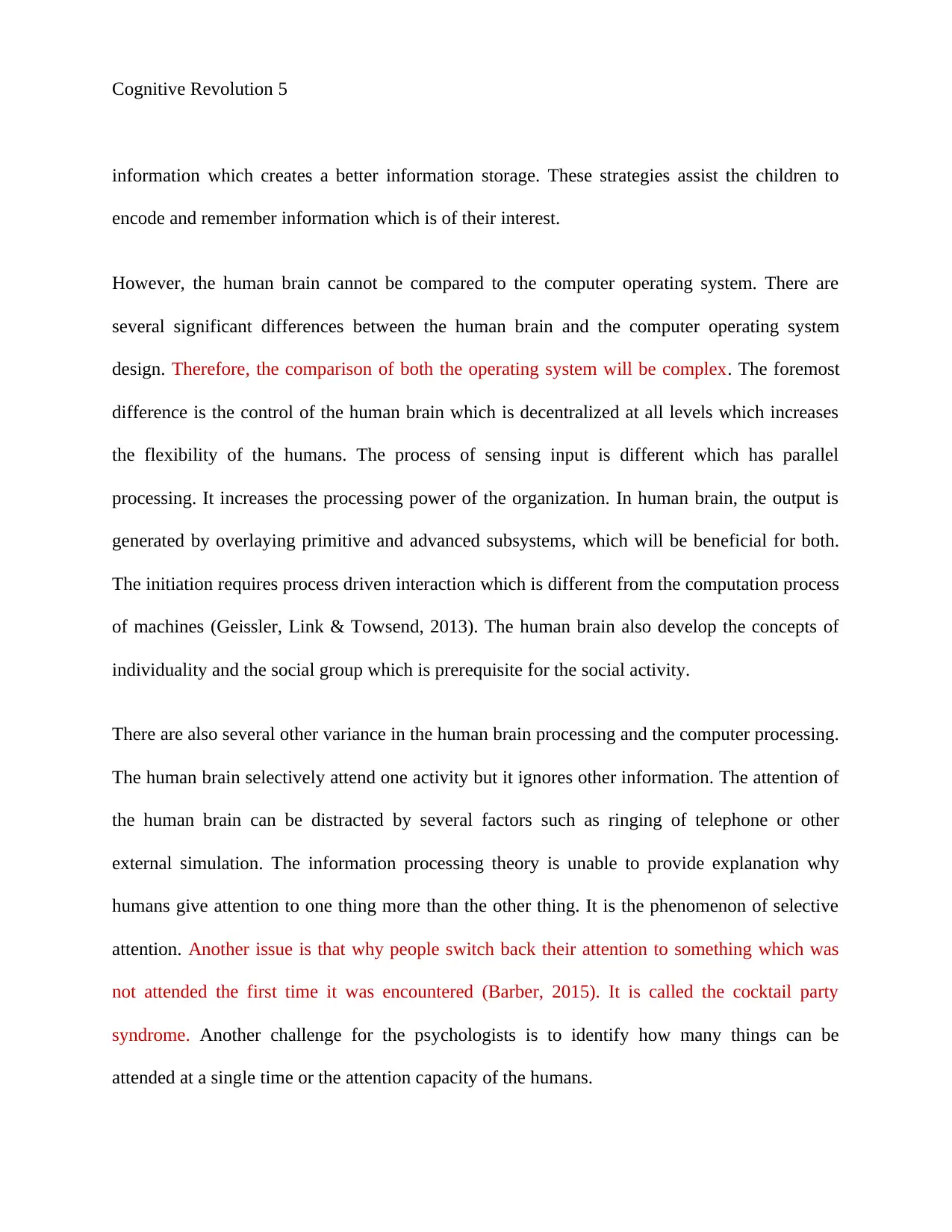
Cognitive Revolution 5
information which creates a better information storage. These strategies assist the children to
encode and remember information which is of their interest.
However, the human brain cannot be compared to the computer operating system. There are
several significant differences between the human brain and the computer operating system
design. Therefore, the comparison of both the operating system will be complex. The foremost
difference is the control of the human brain which is decentralized at all levels which increases
the flexibility of the humans. The process of sensing input is different which has parallel
processing. It increases the processing power of the organization. In human brain, the output is
generated by overlaying primitive and advanced subsystems, which will be beneficial for both.
The initiation requires process driven interaction which is different from the computation process
of machines (Geissler, Link & Towsend, 2013). The human brain also develop the concepts of
individuality and the social group which is prerequisite for the social activity.
There are also several other variance in the human brain processing and the computer processing.
The human brain selectively attend one activity but it ignores other information. The attention of
the human brain can be distracted by several factors such as ringing of telephone or other
external simulation. The information processing theory is unable to provide explanation why
humans give attention to one thing more than the other thing. It is the phenomenon of selective
attention. Another issue is that why people switch back their attention to something which was
not attended the first time it was encountered (Barber, 2015). It is called the cocktail party
syndrome. Another challenge for the psychologists is to identify how many things can be
attended at a single time or the attention capacity of the humans.
information which creates a better information storage. These strategies assist the children to
encode and remember information which is of their interest.
However, the human brain cannot be compared to the computer operating system. There are
several significant differences between the human brain and the computer operating system
design. Therefore, the comparison of both the operating system will be complex. The foremost
difference is the control of the human brain which is decentralized at all levels which increases
the flexibility of the humans. The process of sensing input is different which has parallel
processing. It increases the processing power of the organization. In human brain, the output is
generated by overlaying primitive and advanced subsystems, which will be beneficial for both.
The initiation requires process driven interaction which is different from the computation process
of machines (Geissler, Link & Towsend, 2013). The human brain also develop the concepts of
individuality and the social group which is prerequisite for the social activity.
There are also several other variance in the human brain processing and the computer processing.
The human brain selectively attend one activity but it ignores other information. The attention of
the human brain can be distracted by several factors such as ringing of telephone or other
external simulation. The information processing theory is unable to provide explanation why
humans give attention to one thing more than the other thing. It is the phenomenon of selective
attention. Another issue is that why people switch back their attention to something which was
not attended the first time it was encountered (Barber, 2015). It is called the cocktail party
syndrome. Another challenge for the psychologists is to identify how many things can be
attended at a single time or the attention capacity of the humans.
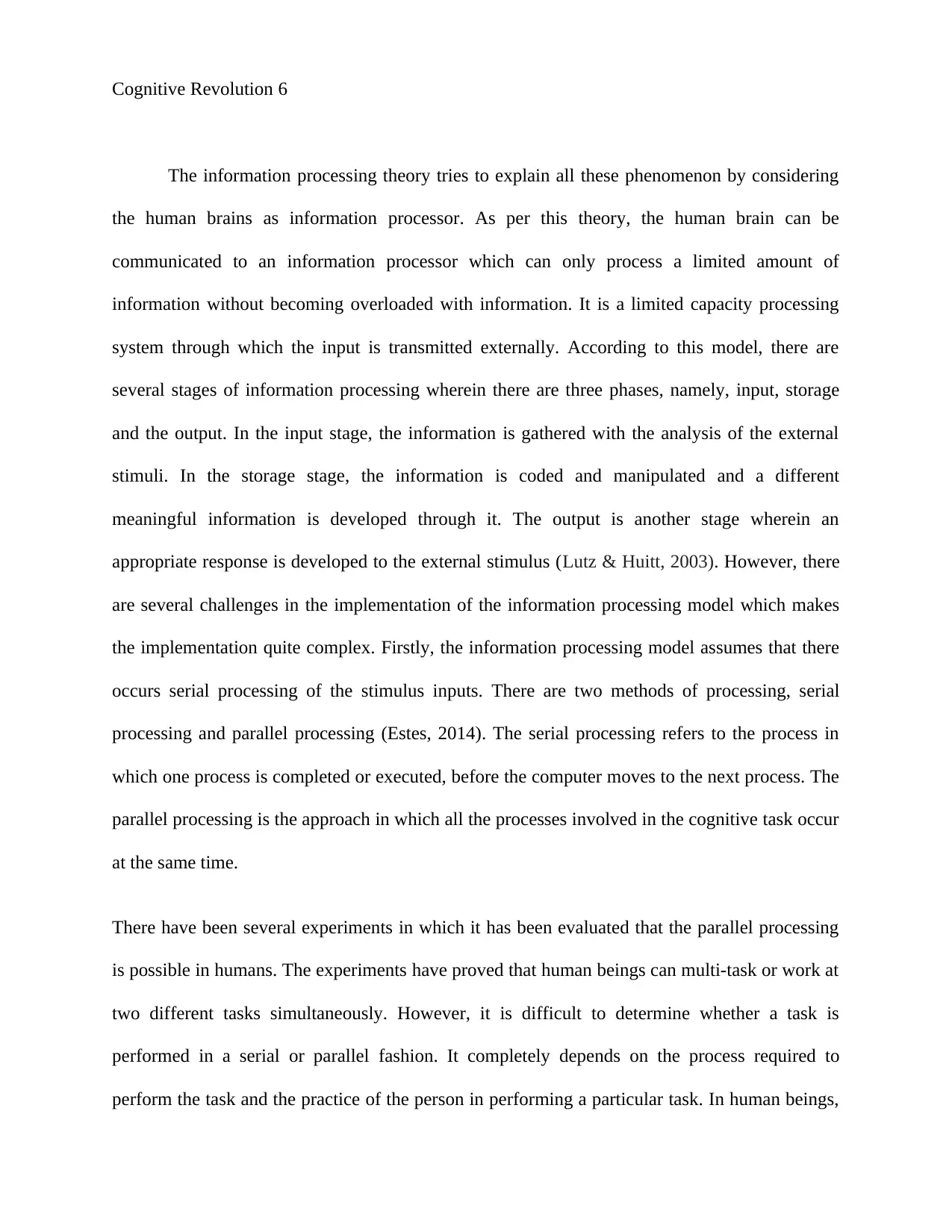
Cognitive Revolution 6
The information processing theory tries to explain all these phenomenon by considering
the human brains as information processor. As per this theory, the human brain can be
communicated to an information processor which can only process a limited amount of
information without becoming overloaded with information. It is a limited capacity processing
system through which the input is transmitted externally. According to this model, there are
several stages of information processing wherein there are three phases, namely, input, storage
and the output. In the input stage, the information is gathered with the analysis of the external
stimuli. In the storage stage, the information is coded and manipulated and a different
meaningful information is developed through it. The output is another stage wherein an
appropriate response is developed to the external stimulus (Lutz & Huitt, 2003). However, there
are several challenges in the implementation of the information processing model which makes
the implementation quite complex. Firstly, the information processing model assumes that there
occurs serial processing of the stimulus inputs. There are two methods of processing, serial
processing and parallel processing (Estes, 2014). The serial processing refers to the process in
which one process is completed or executed, before the computer moves to the next process. The
parallel processing is the approach in which all the processes involved in the cognitive task occur
at the same time.
There have been several experiments in which it has been evaluated that the parallel processing
is possible in humans. The experiments have proved that human beings can multi-task or work at
two different tasks simultaneously. However, it is difficult to determine whether a task is
performed in a serial or parallel fashion. It completely depends on the process required to
perform the task and the practice of the person in performing a particular task. In human beings,
The information processing theory tries to explain all these phenomenon by considering
the human brains as information processor. As per this theory, the human brain can be
communicated to an information processor which can only process a limited amount of
information without becoming overloaded with information. It is a limited capacity processing
system through which the input is transmitted externally. According to this model, there are
several stages of information processing wherein there are three phases, namely, input, storage
and the output. In the input stage, the information is gathered with the analysis of the external
stimuli. In the storage stage, the information is coded and manipulated and a different
meaningful information is developed through it. The output is another stage wherein an
appropriate response is developed to the external stimulus (Lutz & Huitt, 2003). However, there
are several challenges in the implementation of the information processing model which makes
the implementation quite complex. Firstly, the information processing model assumes that there
occurs serial processing of the stimulus inputs. There are two methods of processing, serial
processing and parallel processing (Estes, 2014). The serial processing refers to the process in
which one process is completed or executed, before the computer moves to the next process. The
parallel processing is the approach in which all the processes involved in the cognitive task occur
at the same time.
There have been several experiments in which it has been evaluated that the parallel processing
is possible in humans. The experiments have proved that human beings can multi-task or work at
two different tasks simultaneously. However, it is difficult to determine whether a task is
performed in a serial or parallel fashion. It completely depends on the process required to
perform the task and the practice of the person in performing a particular task. In human beings,
⊘ This is a preview!⊘
Do you want full access?
Subscribe today to unlock all pages.

Trusted by 1+ million students worldwide
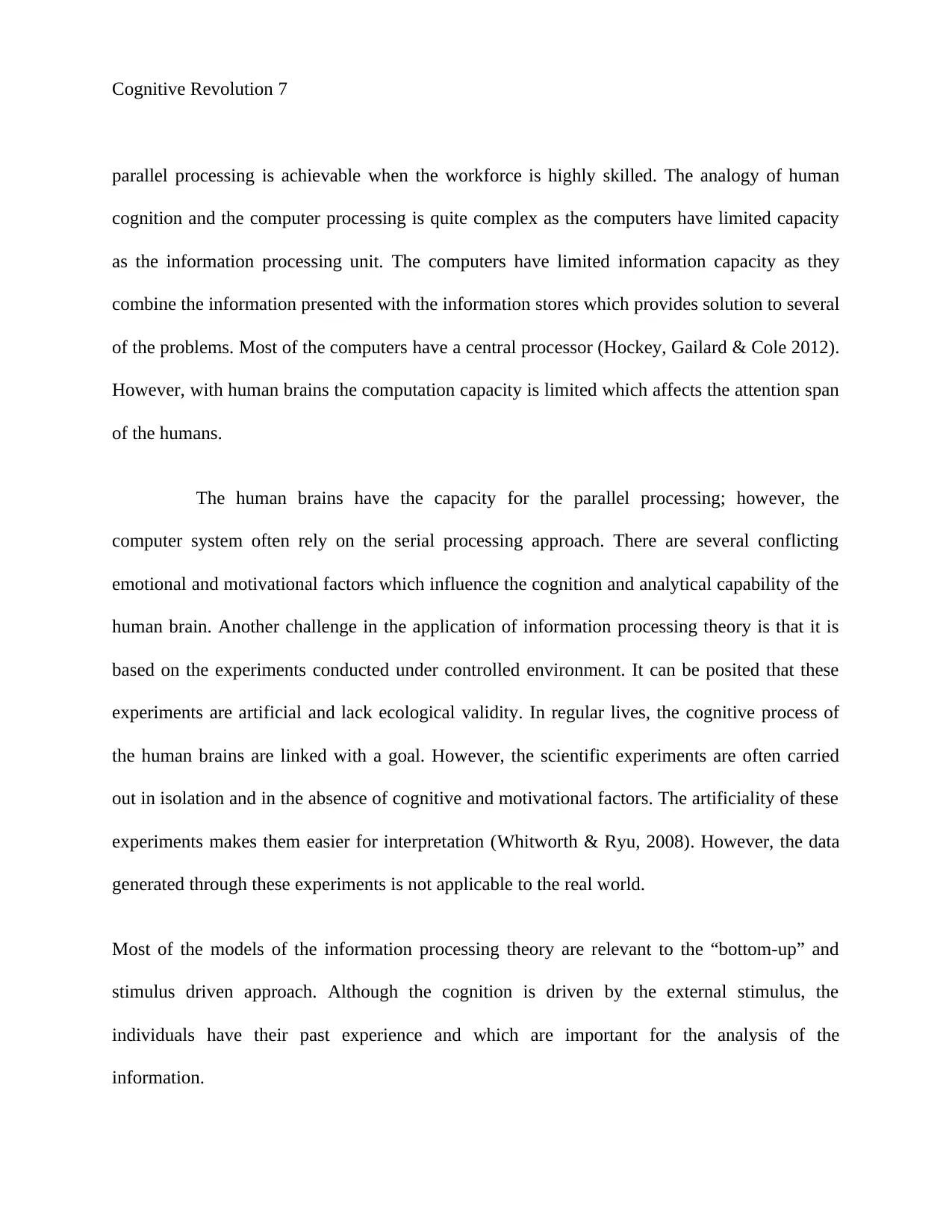
Cognitive Revolution 7
parallel processing is achievable when the workforce is highly skilled. The analogy of human
cognition and the computer processing is quite complex as the computers have limited capacity
as the information processing unit. The computers have limited information capacity as they
combine the information presented with the information stores which provides solution to several
of the problems. Most of the computers have a central processor (Hockey, Gailard & Cole 2012).
However, with human brains the computation capacity is limited which affects the attention span
of the humans.
The human brains have the capacity for the parallel processing; however, the
computer system often rely on the serial processing approach. There are several conflicting
emotional and motivational factors which influence the cognition and analytical capability of the
human brain. Another challenge in the application of information processing theory is that it is
based on the experiments conducted under controlled environment. It can be posited that these
experiments are artificial and lack ecological validity. In regular lives, the cognitive process of
the human brains are linked with a goal. However, the scientific experiments are often carried
out in isolation and in the absence of cognitive and motivational factors. The artificiality of these
experiments makes them easier for interpretation (Whitworth & Ryu, 2008). However, the data
generated through these experiments is not applicable to the real world.
Most of the models of the information processing theory are relevant to the “bottom-up” and
stimulus driven approach. Although the cognition is driven by the external stimulus, the
individuals have their past experience and which are important for the analysis of the
information.
parallel processing is achievable when the workforce is highly skilled. The analogy of human
cognition and the computer processing is quite complex as the computers have limited capacity
as the information processing unit. The computers have limited information capacity as they
combine the information presented with the information stores which provides solution to several
of the problems. Most of the computers have a central processor (Hockey, Gailard & Cole 2012).
However, with human brains the computation capacity is limited which affects the attention span
of the humans.
The human brains have the capacity for the parallel processing; however, the
computer system often rely on the serial processing approach. There are several conflicting
emotional and motivational factors which influence the cognition and analytical capability of the
human brain. Another challenge in the application of information processing theory is that it is
based on the experiments conducted under controlled environment. It can be posited that these
experiments are artificial and lack ecological validity. In regular lives, the cognitive process of
the human brains are linked with a goal. However, the scientific experiments are often carried
out in isolation and in the absence of cognitive and motivational factors. The artificiality of these
experiments makes them easier for interpretation (Whitworth & Ryu, 2008). However, the data
generated through these experiments is not applicable to the real world.
Most of the models of the information processing theory are relevant to the “bottom-up” and
stimulus driven approach. Although the cognition is driven by the external stimulus, the
individuals have their past experience and which are important for the analysis of the
information.
Paraphrase This Document
Need a fresh take? Get an instant paraphrase of this document with our AI Paraphraser
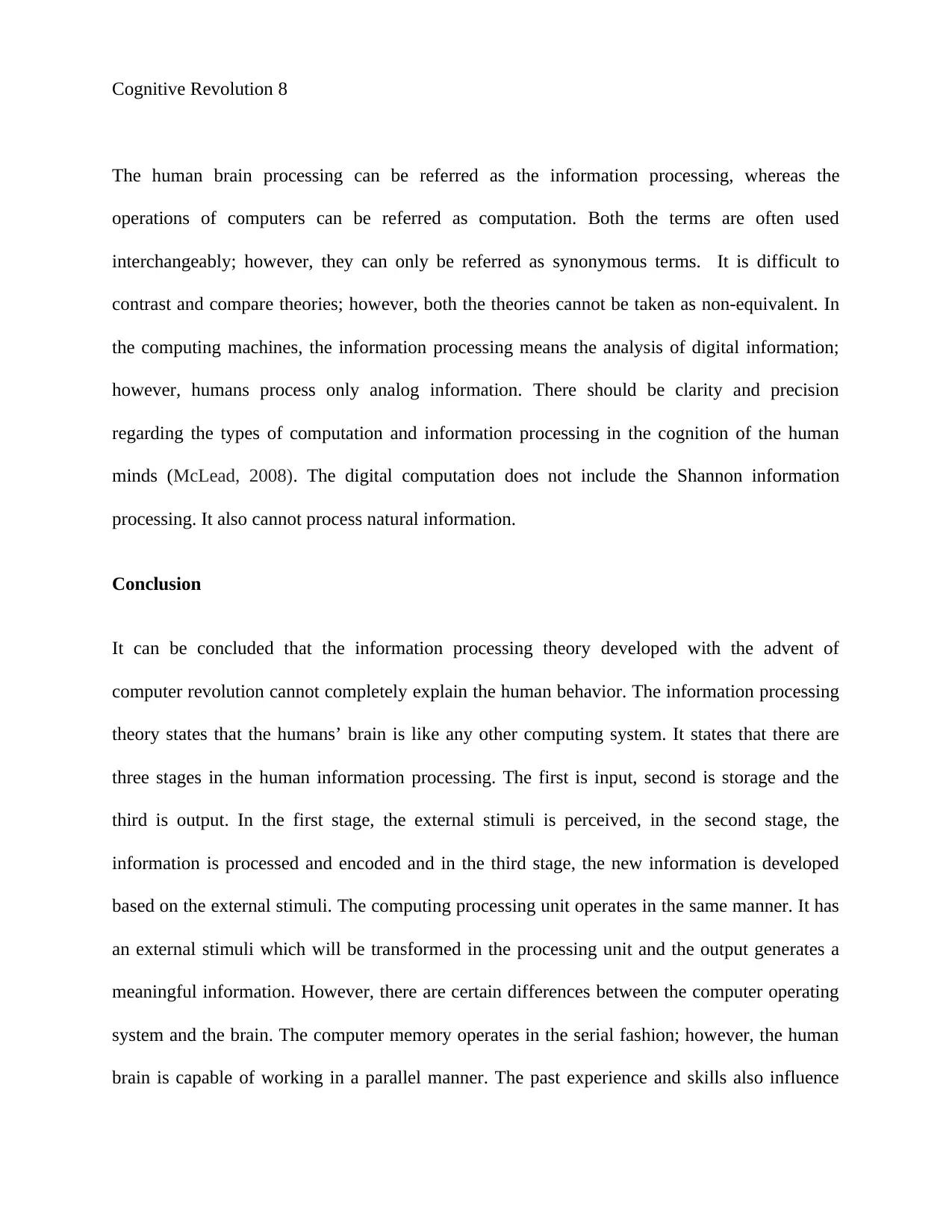
Cognitive Revolution 8
The human brain processing can be referred as the information processing, whereas the
operations of computers can be referred as computation. Both the terms are often used
interchangeably; however, they can only be referred as synonymous terms. It is difficult to
contrast and compare theories; however, both the theories cannot be taken as non-equivalent. In
the computing machines, the information processing means the analysis of digital information;
however, humans process only analog information. There should be clarity and precision
regarding the types of computation and information processing in the cognition of the human
minds (McLead, 2008). The digital computation does not include the Shannon information
processing. It also cannot process natural information.
Conclusion
It can be concluded that the information processing theory developed with the advent of
computer revolution cannot completely explain the human behavior. The information processing
theory states that the humans’ brain is like any other computing system. It states that there are
three stages in the human information processing. The first is input, second is storage and the
third is output. In the first stage, the external stimuli is perceived, in the second stage, the
information is processed and encoded and in the third stage, the new information is developed
based on the external stimuli. The computing processing unit operates in the same manner. It has
an external stimuli which will be transformed in the processing unit and the output generates a
meaningful information. However, there are certain differences between the computer operating
system and the brain. The computer memory operates in the serial fashion; however, the human
brain is capable of working in a parallel manner. The past experience and skills also influence
The human brain processing can be referred as the information processing, whereas the
operations of computers can be referred as computation. Both the terms are often used
interchangeably; however, they can only be referred as synonymous terms. It is difficult to
contrast and compare theories; however, both the theories cannot be taken as non-equivalent. In
the computing machines, the information processing means the analysis of digital information;
however, humans process only analog information. There should be clarity and precision
regarding the types of computation and information processing in the cognition of the human
minds (McLead, 2008). The digital computation does not include the Shannon information
processing. It also cannot process natural information.
Conclusion
It can be concluded that the information processing theory developed with the advent of
computer revolution cannot completely explain the human behavior. The information processing
theory states that the humans’ brain is like any other computing system. It states that there are
three stages in the human information processing. The first is input, second is storage and the
third is output. In the first stage, the external stimuli is perceived, in the second stage, the
information is processed and encoded and in the third stage, the new information is developed
based on the external stimuli. The computing processing unit operates in the same manner. It has
an external stimuli which will be transformed in the processing unit and the output generates a
meaningful information. However, there are certain differences between the computer operating
system and the brain. The computer memory operates in the serial fashion; however, the human
brain is capable of working in a parallel manner. The past experience and skills also influence
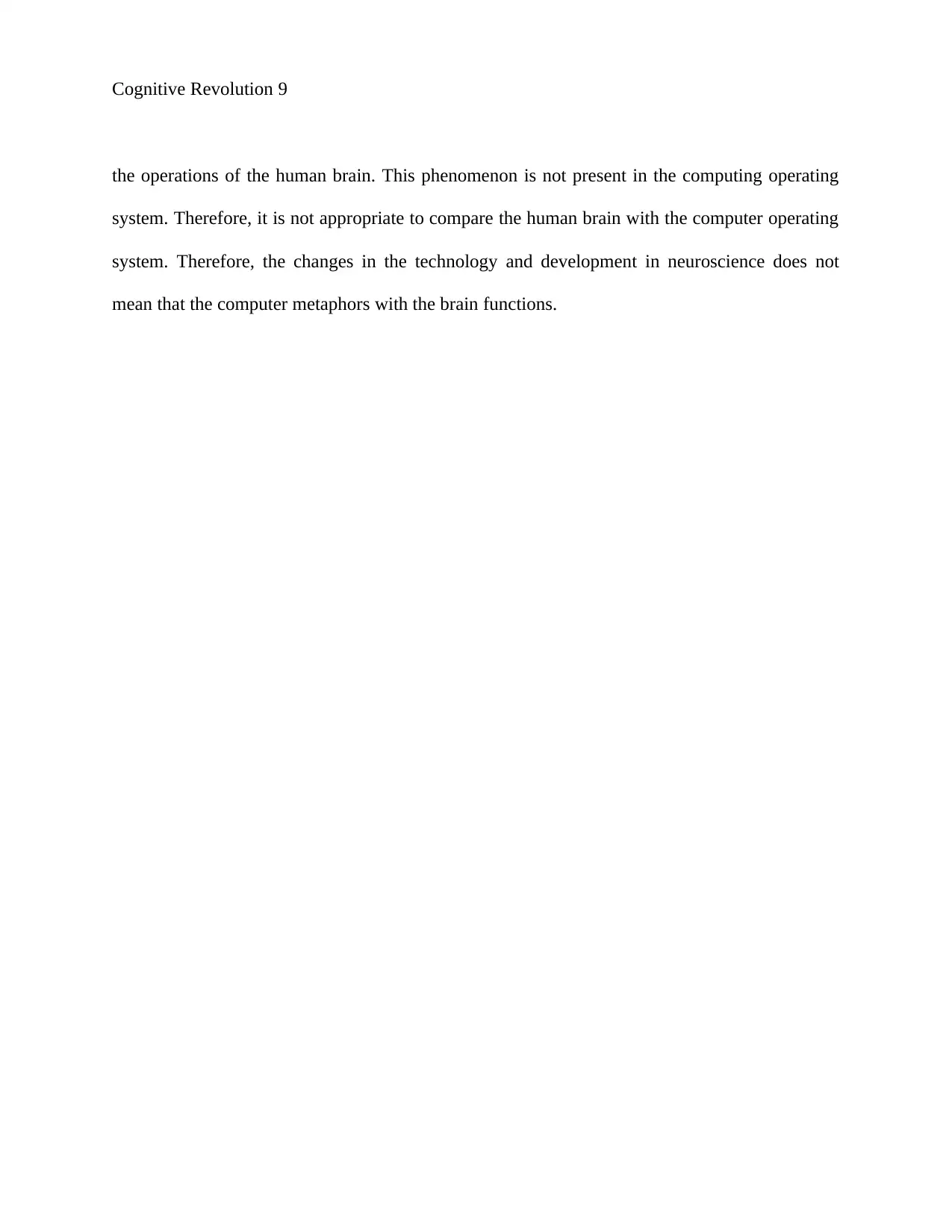
Cognitive Revolution 9
the operations of the human brain. This phenomenon is not present in the computing operating
system. Therefore, it is not appropriate to compare the human brain with the computer operating
system. Therefore, the changes in the technology and development in neuroscience does not
mean that the computer metaphors with the brain functions.
the operations of the human brain. This phenomenon is not present in the computing operating
system. Therefore, it is not appropriate to compare the human brain with the computer operating
system. Therefore, the changes in the technology and development in neuroscience does not
mean that the computer metaphors with the brain functions.
⊘ This is a preview!⊘
Do you want full access?
Subscribe today to unlock all pages.

Trusted by 1+ million students worldwide
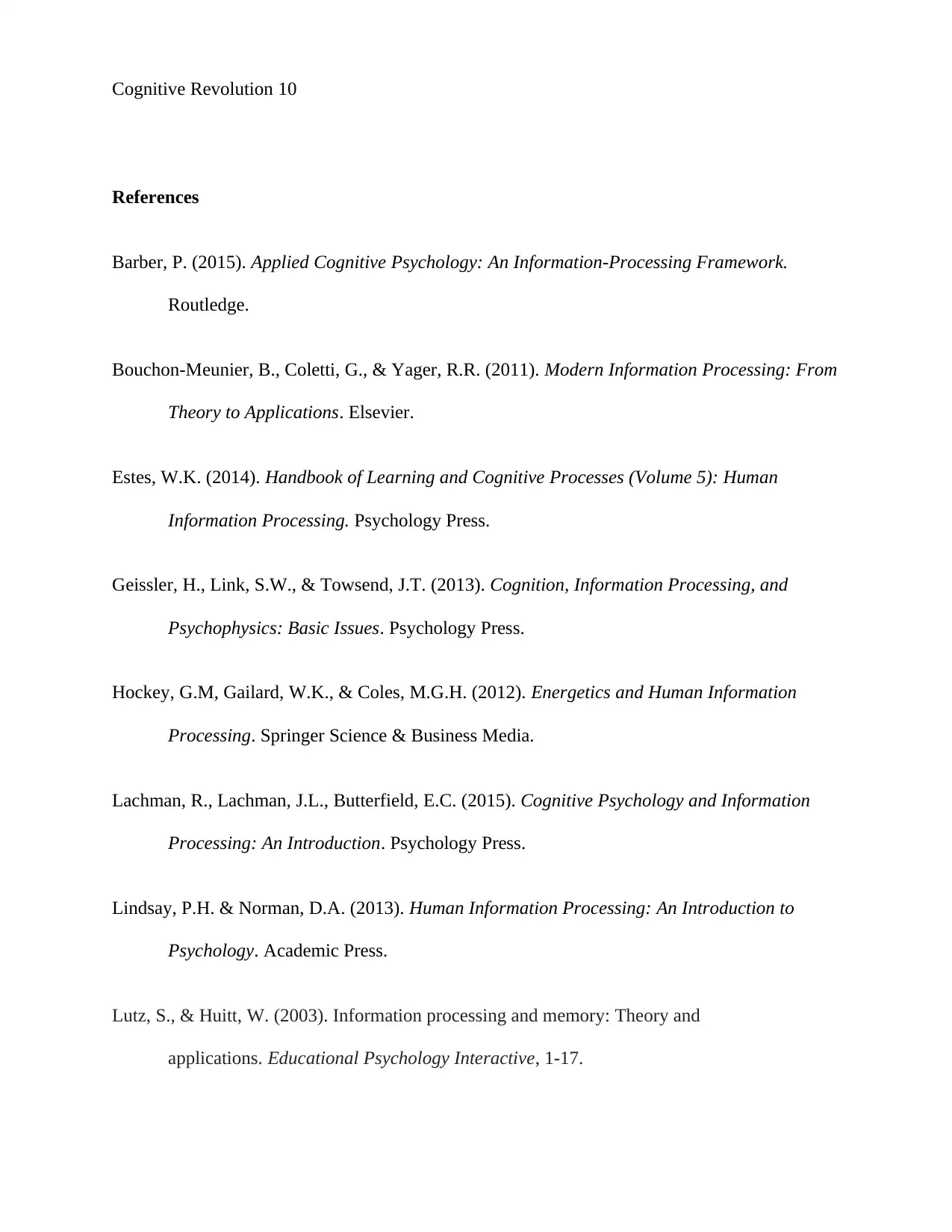
Cognitive Revolution 10
References
Barber, P. (2015). Applied Cognitive Psychology: An Information-Processing Framework.
Routledge.
Bouchon-Meunier, B., Coletti, G., & Yager, R.R. (2011). Modern Information Processing: From
Theory to Applications. Elsevier.
Estes, W.K. (2014). Handbook of Learning and Cognitive Processes (Volume 5): Human
Information Processing. Psychology Press.
Geissler, H., Link, S.W., & Towsend, J.T. (2013). Cognition, Information Processing, and
Psychophysics: Basic Issues. Psychology Press.
Hockey, G.M, Gailard, W.K., & Coles, M.G.H. (2012). Energetics and Human Information
Processing. Springer Science & Business Media.
Lachman, R., Lachman, J.L., Butterfield, E.C. (2015). Cognitive Psychology and Information
Processing: An Introduction. Psychology Press.
Lindsay, P.H. & Norman, D.A. (2013). Human Information Processing: An Introduction to
Psychology. Academic Press.
Lutz, S., & Huitt, W. (2003). Information processing and memory: Theory and
applications. Educational Psychology Interactive, 1-17.
References
Barber, P. (2015). Applied Cognitive Psychology: An Information-Processing Framework.
Routledge.
Bouchon-Meunier, B., Coletti, G., & Yager, R.R. (2011). Modern Information Processing: From
Theory to Applications. Elsevier.
Estes, W.K. (2014). Handbook of Learning and Cognitive Processes (Volume 5): Human
Information Processing. Psychology Press.
Geissler, H., Link, S.W., & Towsend, J.T. (2013). Cognition, Information Processing, and
Psychophysics: Basic Issues. Psychology Press.
Hockey, G.M, Gailard, W.K., & Coles, M.G.H. (2012). Energetics and Human Information
Processing. Springer Science & Business Media.
Lachman, R., Lachman, J.L., Butterfield, E.C. (2015). Cognitive Psychology and Information
Processing: An Introduction. Psychology Press.
Lindsay, P.H. & Norman, D.A. (2013). Human Information Processing: An Introduction to
Psychology. Academic Press.
Lutz, S., & Huitt, W. (2003). Information processing and memory: Theory and
applications. Educational Psychology Interactive, 1-17.
Paraphrase This Document
Need a fresh take? Get an instant paraphrase of this document with our AI Paraphraser
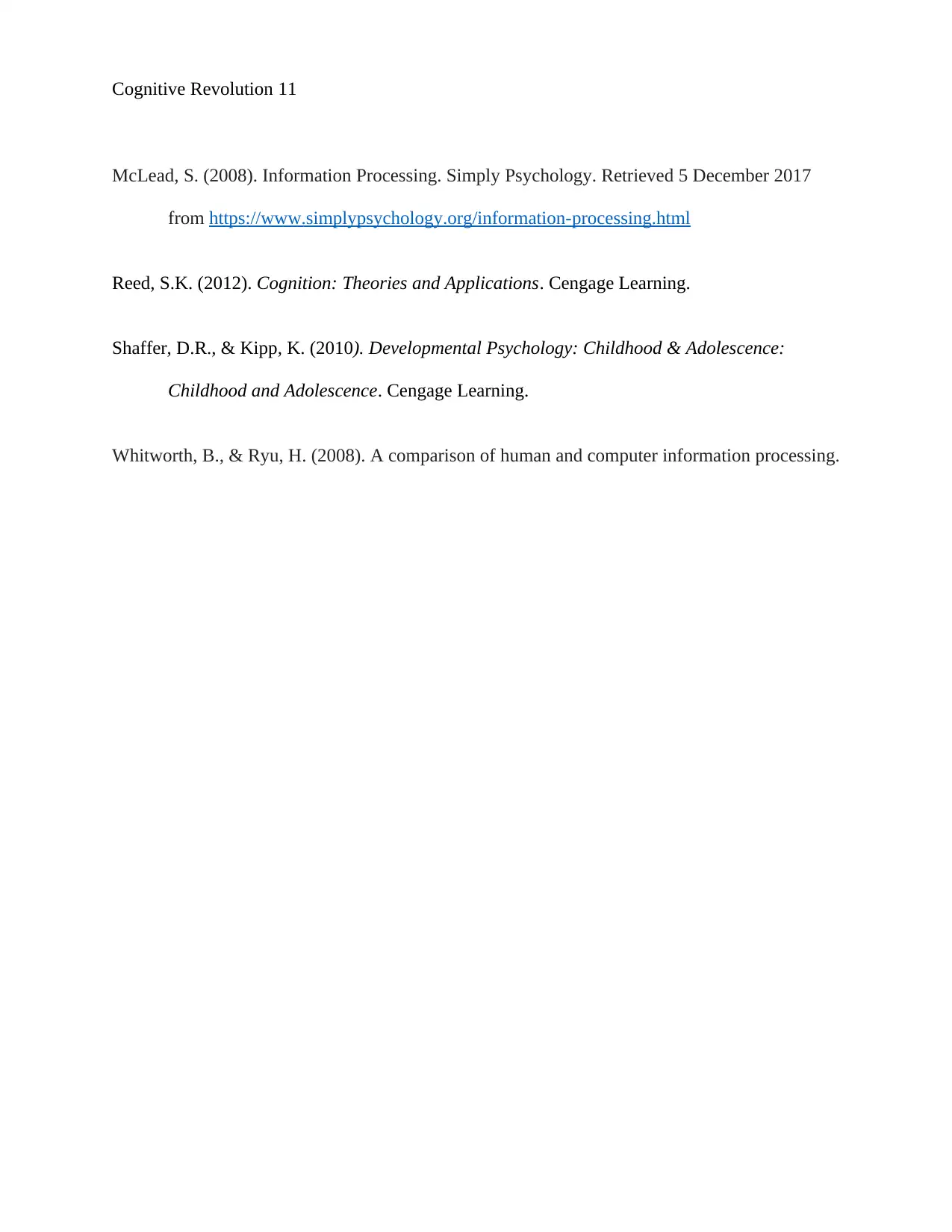
Cognitive Revolution 11
McLead, S. (2008). Information Processing. Simply Psychology. Retrieved 5 December 2017
from https://www.simplypsychology.org/information-processing.html
Reed, S.K. (2012). Cognition: Theories and Applications. Cengage Learning.
Shaffer, D.R., & Kipp, K. (2010). Developmental Psychology: Childhood & Adolescence:
Childhood and Adolescence. Cengage Learning.
Whitworth, B., & Ryu, H. (2008). A comparison of human and computer information processing.
McLead, S. (2008). Information Processing. Simply Psychology. Retrieved 5 December 2017
from https://www.simplypsychology.org/information-processing.html
Reed, S.K. (2012). Cognition: Theories and Applications. Cengage Learning.
Shaffer, D.R., & Kipp, K. (2010). Developmental Psychology: Childhood & Adolescence:
Childhood and Adolescence. Cengage Learning.
Whitworth, B., & Ryu, H. (2008). A comparison of human and computer information processing.
1 out of 11
Related Documents
Your All-in-One AI-Powered Toolkit for Academic Success.
+13062052269
info@desklib.com
Available 24*7 on WhatsApp / Email
![[object Object]](/_next/static/media/star-bottom.7253800d.svg)
Unlock your academic potential
Copyright © 2020–2025 A2Z Services. All Rights Reserved. Developed and managed by ZUCOL.





